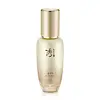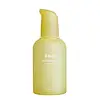What's inside
What's inside
 Key Ingredients
Key Ingredients

 Benefits
Benefits

 Concerns
Concerns

 Ingredients Side-by-side
Ingredients Side-by-side

Water
Skin ConditioningDipropylene Glycol
HumectantNiacinamide
SmoothingButylene Glycol
Humectant1,2-Hexanediol
Skin ConditioningPanax Ginseng Root Extract
EmollientGinsenosides
Skin ConditioningMorus Alba Bark Extract
Skin ConditioningOphiopogon Japonicus Root Extract
Skin ConditioningScutellaria Baicalensis Root Extract
AstringentPanthenol
Skin ConditioningPhenyl Trimethicone
Skin ConditioningTriethylhexanoin
MaskingPaeonia Suffruticosa Root Extract
Skin ProtectingAngelica Acutiloba Root Extract
Skin ConditioningPrunus Persica Kernel Extract
MoisturisingPaeonia Lactiflora Extract
AstringentPlantago Asiatica Extract
Skin ConditioningGlycyrrhiza Uralensis Root Extract
Skin ConditioningSchisandra Chinensis Fruit Extract
Skin ConditioningTricholoma Matsutake Extract
Skin ConditioningZingiber Officinale Root Extract
MaskingZanthoxylum Piperitum Fruit Extract
Skin ConditioningAtractylodes Japonica Rhizome Extract
Skin ConditioningCitrus Unshiu Peel Extract
MaskingPoncirus Trifoliata Fruit Extract
Skin ConditioningChaenomeles Sinensis Fruit Extract
AntioxidantDiospyros Kaki Leaf Extract
Skin ProtectingCinnamomum Cassia Bark Extract
MaskingArtemisia Princeps Leaf Extract
Skin ConditioningChrysanthellum Indicum Extract
Skin ConditioningCamellia Sinensis Leaf Extract
AntimicrobialPogostemon Cablin Leaf Extract
PerfumingPrunus Armeniaca Kernel Extract
Skin ConditioningPoria Cocos Sclerotium Extract
AstringentAngelica Tenuissima Root Extract
Skin ConditioningPhaseolus Radiatus Seed Extract
Skin ConditioningCeratonia Siliqua Fruit Extract
MaskingTrichosanthes Kirilowii Root Extract
Skin ProtectingLycium Chinense Fruit Extract
AntioxidantCornus Officinalis Fruit Extract
Skin ConditioningRehmannia Chinensis Root Extract
Skin ConditioningRehmannia Glutinosa Root Extract
Skin ConditioningHydroxypropyl Cyclodextrin
MaskingAdenosine
Skin ConditioningXanthan Gum
EmulsifyingSodium Polyacrylate
AbsorbentPotassium Acrylates/C10-30 Alkyl Acrylate Crosspolymer
Theobroma Cacao Extract
Skin ConditioningTromethamine
BufferingAroma
Water, Dipropylene Glycol, Niacinamide, Butylene Glycol, 1,2-Hexanediol, Panax Ginseng Root Extract, Ginsenosides, Morus Alba Bark Extract, Ophiopogon Japonicus Root Extract, Scutellaria Baicalensis Root Extract, Panthenol, Phenyl Trimethicone, Triethylhexanoin, Paeonia Suffruticosa Root Extract, Angelica Acutiloba Root Extract, Prunus Persica Kernel Extract, Paeonia Lactiflora Extract, Plantago Asiatica Extract, Glycyrrhiza Uralensis Root Extract, Schisandra Chinensis Fruit Extract, Tricholoma Matsutake Extract, Zingiber Officinale Root Extract, Zanthoxylum Piperitum Fruit Extract, Atractylodes Japonica Rhizome Extract, Citrus Unshiu Peel Extract, Poncirus Trifoliata Fruit Extract, Chaenomeles Sinensis Fruit Extract, Diospyros Kaki Leaf Extract, Cinnamomum Cassia Bark Extract, Artemisia Princeps Leaf Extract, Chrysanthellum Indicum Extract, Camellia Sinensis Leaf Extract, Pogostemon Cablin Leaf Extract, Prunus Armeniaca Kernel Extract, Poria Cocos Sclerotium Extract, Angelica Tenuissima Root Extract, Phaseolus Radiatus Seed Extract, Ceratonia Siliqua Fruit Extract, Trichosanthes Kirilowii Root Extract, Lycium Chinense Fruit Extract, Cornus Officinalis Fruit Extract, Rehmannia Chinensis Root Extract, Rehmannia Glutinosa Root Extract, Hydroxypropyl Cyclodextrin, Adenosine, Xanthan Gum, Sodium Polyacrylate, Potassium Acrylates/C10-30 Alkyl Acrylate Crosspolymer, Theobroma Cacao Extract, Tromethamine, Aroma
Citrus Junos Fruit Extract 82.54%
Skin ConditioningButylene Glycol
HumectantDipropylene Glycol
HumectantWater
Skin ConditioningGlycereth-26
HumectantNiacinamide
SmoothingChondrus Crispus Extract
Skin ConditioningSaccharum Officinarum Extract
MoisturisingSodium Hyaluronate
HumectantCitrus Junos Peel Extract
Skin ConditioningLactobacillus Ferment Lysate
Skin ConditioningPanthenol
Skin ConditioningAcrylates/C10-30 Alkyl Acrylate Crosspolymer
Emulsion StabilisingCholeth-24
EmulsifyingGlycerin
HumectantDiphenyl Dimethicone
EmollientTromethamine
BufferingTriethylhexanoin
MaskingHydrogenated Lecithin
EmulsifyingEthylhexylglycerin
Skin ConditioningCitrus Junos Peel Oil 0.03%
AstringentPentylene Glycol
Skin ConditioningTocopherol
Antioxidant1,2-Hexanediol
Skin ConditioningAscorbic Acid
AntioxidantDisodium EDTA
Limonene
PerfumingCitrus Junos Fruit Extract 82.54%, Butylene Glycol, Dipropylene Glycol, Water, Glycereth-26, Niacinamide, Chondrus Crispus Extract, Saccharum Officinarum Extract, Sodium Hyaluronate, Citrus Junos Peel Extract, Lactobacillus Ferment Lysate, Panthenol, Acrylates/C10-30 Alkyl Acrylate Crosspolymer, Choleth-24, Glycerin, Diphenyl Dimethicone, Tromethamine, Triethylhexanoin, Hydrogenated Lecithin, Ethylhexylglycerin, Citrus Junos Peel Oil 0.03%, Pentylene Glycol, Tocopherol, 1,2-Hexanediol, Ascorbic Acid, Disodium EDTA, Limonene
Ingredients Explained
These ingredients are found in both products.
Ingredients higher up in an ingredient list are typically present in a larger amount.
1,2-Hexanediol is a synthetic liquid and another multi-functional powerhouse.
It is a:
- Humectant, drawing moisture into the skin
- Emollient, helping to soften skin
- Solvent, dispersing and stabilizing formulas
- Preservative booster, enhancing the antimicrobial activity of other preservatives
Butylene Glycol (or BG) is used within cosmetic products for a few different reasons:
Overall, Butylene Glycol is a safe and well-rounded ingredient that works well with other ingredients.
Though this ingredient works well with most skin types, some people with sensitive skin may experience a reaction such as allergic rashes, closed comedones, or itchiness.
Learn more about Butylene GlycolDipropylene Glycol is a synthetically created humectant, stabilizer, and solvent.
This ingredient helps:
Dipropylene glycol is technically an alcohol, but it belongs to the glycol family (often considered part of the ‘good’ alcohols). This means it is hydrating and gentle on skin unlike drying solvent alcohols like denatured alcohol.
As a masking agent, Dipropylene Glycol can be used to cover the smell of other ingredients. However, it does not have a scent.
Studies show Dipropylene Glycol is considered safe to use in skincare.
Learn more about Dipropylene GlycolNiacinamide is a multitasking form of vitamin B3 that strengthens the skin barrier, reduces pores and dark spots, regulates oil, and improves signs of aging.
And the best part? It's gentle and well-tolerated by most skin types, including sensitive and reactive skin.
You might have heard of "niacin flush", or the reddening of skin that causes itchiness. Niacinamide has not been found to cause this.
In very rare cases, some individuals may not be able to tolerate niacinamide at all or experience an allergic reaction to it.
If you are experiencing flaking, irritation, and dryness with this ingredient, be sure to double check all your products as this ingredient can be found in all categories of skincare.
When incorporating niacinamide into your routine, look out for concentration amounts. Typically, 5% niacinamide provides benefits such as fading dark spots. However, if you have sensitive skin, it is better to begin with a smaller concentration.
When you apply niacinamide to your skin, your body converts it into nicotinamide adenine dinucleotide (NAD). NAD is an essential coenzyme that is already found in your cells as "fuel" and powers countless biological processes.
In your skin, NAD helps repair cell damage, produce new healthy cells, support collagen production, strengthen the skin barrier, and fight environmental stressors (like UV and pollution).
Our natural NAD levels start to decline with age, leading to slower skin repair, visible aging, and a weaker skin barrier. By providing your skin niacinamide, you're recharging your skin's NAD levels. This leads to stronger, healthier, and younger looking skin.
Another name for vitamin B3 is nicotinamide. This vitamin is water-soluble and our bodies don't store it. We obtain Vitamin B3 from either food or skincare. Meat, fish, wheat, yeast, and leafy greens contain vitamin B3.
The type of niacinamide used in skincare is synthetically created.
Learn more about NiacinamidePanthenol is a common ingredient that helps hydrate and soothe the skin. It is found naturally in our skin and hair.
There are two forms of panthenol: D and L.
D-panthenol is also known as dexpanthenol. Most cosmetics use dexpanthenol or a mixture of D and L-panthenol.
Panthenol is famous due to its ability to go deeper into the skin's layers. Using this ingredient has numerous pros (and no cons):
Like hyaluronic acid, panthenol is a humectant. Humectants are able to bind and hold large amounts of water to keep skin hydrated.
This ingredient works well for wound healing. It works by increasing tissue in the wound and helps close open wounds.
Once oxidized, panthenol converts to pantothenic acid. Panthothenic acid is found in all living cells.
This ingredient is also referred to as pro-vitamin B5.
Learn more about PanthenolTriethylhexanoin is created from glycerin and 2-ethylhexanoic acid. It is a solvent and emollient.
As a solvent, Triethylhexanoin helps dissolve ingredients to stable bases or help evenly distribute ingredients throughout the product.
It is also an emollient and helps condition the skin.
Learn more about TriethylhexanoinTromethamine helps balance the pH and improve the texture of a product. It is synthetically created.
As an emulsifier, Tromethamine prevents oil and water ingredients from separating. This helps stabilize the product and elongate a product's shelf life. Tromethamine also makes a product thicker.
Tromethamine helps balance the pH level of a product. Normal pH level of skin is slightly acidic (~4.75-5.5). The acidity of our skin is maintained by our glands and skin biome. Being slightly acidic allows our skin to create an "acid mantle". This acid mantle is a thin barrier that protects our skin from bacteria and contaminants.
Oral Tromethanmine is an anti-inflammatory drug but plays the role of masking, adding fragrance, and/or balancing pH in skincare.
1,3-Propanediol, 2-amino-2-(hydroxymethyl)-
Learn more about TromethamineWater. It's the most common cosmetic ingredient of all. You'll usually see it at the top of ingredient lists, meaning that it makes up the largest part of the product.
So why is it so popular? Water most often acts as a solvent - this means that it helps dissolve other ingredients into the formulation.
You'll also recognize water as that liquid we all need to stay alive. If you see this, drink a glass of water. Stay hydrated!
Learn more about Water